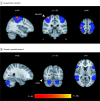Associations Between Longitudinal Trajectories of Cognitive and Social Activities and Brain Health in Old Age
- PMID: 32816032
- PMCID: PMC7441365
- DOI: 10.1001/jamanetworkopen.2020.13793
Associations Between Longitudinal Trajectories of Cognitive and Social Activities and Brain Health in Old Age
Abstract
Importance: Prior neuroimaging studies have found that late-life participation in cognitive (eg, reading) and social (eg, visiting friends and family) leisure activities are associated with magnetic resonance imaging (MRI) markers of the aging brain, but little is known about the neural and cognitive correlates of changes in leisure activities during the life span.
Objectives: To examine trajectories of cognitive and social activities from midlife to late life and evaluate whether these trajectories are associated with brain structure, functional connectivity, and cognition.
Design, setting, and participants: This prospective cohort included participants enrolled in the Whitehall II study and its MRI substudy based in the UK. Participants provided information on their leisure activities at 5 times during calendar years 1997 to 1999, 2002 to 2004, 2006, 2007 to 2009, and 2011 to 2013 and underwent MRI and cognitive battery testing from January 1, 2012, to December 31, 2016. Data analysis was performed from October 7, 2017, to July 15, 2019.
Main outcome and measures: Growth curve models and latent class growth analysis were used to identify longitudinal trajectories of cognitive and social activities. Multiple linear regression was used to evaluate associations between activity trajectories and gray matter, white matter microstructure, functional connectivity, and cognition.
Results: A total of 574 individuals (468 [81.5%] men; mean [SD] age, 69.9 [4.9] years; median Montreal Cognitive Assessment score, 28 [interquartile range, 26-28]) were included in the present analysis. During a mean (SD) of 15 (4.2) years, cognitive and social activity levels increased during midlife before reaching a plateau in late life. Both baseline (global cognition: unstandardized β [SE], 0.955 [0.285], uncorrected P = .001; executive function: β [SE], 1.831 [0.499], uncorrected P < .001; memory: β [SE], 1.394 [0.550], uncorrected P = .01; processing speed: β [SE], 1.514 [0.528], uncorrected P = .004) and change (global cognition: β [SE], -1.382 [0.492], uncorrected P = .005, executive function: β [SE], -2.219 [0.865], uncorrected P = .01; memory: β [SE], -2.355 [0.948], uncorrected P = .01) in cognitive activities were associated with multiple domains of cognition as well as global gray matter volume (β [SE], -0.910 [0.388], uncorrected P = .02). Baseline (β [SE], 1.695 [0.525], uncorrected P = .001) and change (β [SE], 2.542 [1.026], uncorrected P = .01) in social activities were associated only with executive function, in addition to voxelwise measures of functional connectivity that involved sensorimotor (quadratic change in social activities: number of voxels, 306; P = 0.01) and temporoparietal (linear change in social activities: number of voxels, 16; P = .02) networks. Otherwise, no voxelwise associations were found with gray matter, white matter, or resting-state functional connectivity. False discovery rate corrections for multiple comparisons suggested that the association between cognitive activity levels and executive function was robust (β [SE], 1.831 [0.499], false discovery rate P < .001).
Conclusions and relevance: The findings suggest that a life course approach may delineate the association between leisure activities and cognitive and brain health and that interventions aimed at improving and maintaining cognitive engagement may be valuable for the cognitive health of community-dwelling older adults.
Conflict of interest statement
Figures




References
Publication types
MeSH terms
Grants and funding
- S011676/MRC_/Medical Research Council/United Kingdom
- R01 AG056477/AG/NIA NIH HHS/United States
- MR/L023784/1/MRC_/Medical Research Council/United Kingdom
- J-0901/PUK_/Parkinson's UK/United Kingdom
- 32334/BHF_/British Heart Foundation/United Kingdom
- MR/S011676/1/MRC_/Medical Research Council/United Kingdom
- MR/K013351/1/MRC_/Medical Research Council/United Kingdom
- R024227/MRC_/Medical Research Council/United Kingdom
- MR/M024962/1/MRC_/Medical Research Council/United Kingdom
- G1001354/MRC_/Medical Research Council/United Kingdom
- MR/R024227/1/MRC_/Medical Research Council/United Kingdom
- RF1 AG062553/AG/NIA NIH HHS/United States
- MC_EX_MR/N50192X/1/MRC_/Medical Research Council/United Kingdom
LinkOut - more resources
Full Text Sources
Medical

